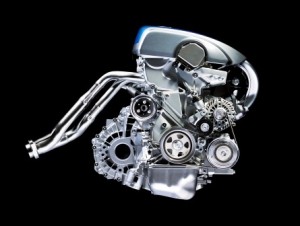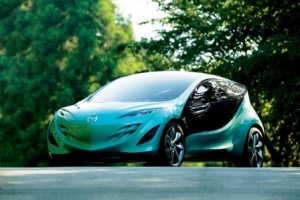Mazda showed its next generation of gasoline and diesel powertrains today at the Tokyo Motor Show, and they are notable for a simple approach to boosting fuel economy and output by a claimed 30% between now and 2015.
It packages some of the technologies in the Kiyora, “a next-generation concept car that demonstrates the range of Mazda’s upcoming eco-technologies.”
Kiyora combines a 1.3-liter Sky-G engine, the Sky-Drive transmission, and the first two stages of Mazda’s electric device program — i-stop and regenerative braking — as well as weight reduction and aerodynamic advancements. All of which combine to achieve extremely high fuel economy of 32 kilometers per liter, about 75 mpg, without any assistance from an electric motor.
Mazda appears to be favoring basic work on combustion efficiency, lightweight materials, and low friction engines and transmissions, while other companies, including now minority shareholder Ford, are pursuing more expensive forced induction designs with one or more turbochargers or expensive plug-in hybrids and electric vehicles with $10,000 (or more) battery packs. The Ford approach, in theory, will allow it to continue to sell a mix of vehicles that are larger and heavier than Mazda’s, which it of course it already does. The question is where the bulk of the customers will be in the future?
“Mazda will first work to enhance our base technologies — engines, transmissions, weight reduction and aerodynamics — in order to optimize basic vehicle performance,” said Takashi Yamanouchi, Representative Director, President and CEO. “We feel that by doing this, we will be able to offer not just a small number of customers, but all our customers, driving pleasure as well as eco-friendliness and reassuring safety levels.”

The 2-liter Sky-G engine will appear first in Japan during 2011 in an updated Demio. Initially about a 15% improvement in fuel economy is expected.
The difference in cost to customers could give Mazda a potential pricing advantage of thousands of dollars on a new vehicle, and ultimately provide its owners with lower operating and maintenance costs. It could also benefit shareholders with reduced warranty claims and higher customer satisfaction levels.
Mazda’s new 2.0-liter gasoline and 2.2-liter diesel engines are direct fuel injection designs that will be used globally in Mazda products. If the claimed efficiencies appears, and Mazda says prototypes already meet initial targets, then the fuel economy of the current Demio (Mazda2) B-car will be obtained by the Axela (Mazda3) compact.
The 2-liter Sky-G engine, for Gasoline, will debut first in Japan during 2011 in an updated Demio. Initially about a 15% improvement in fuel economy is expected.
Next is the Sky-D, or diesel engine, which offers about 20% better fuel efficiency than Mazda’s current 2.2-liter diesel. That means a vehicle the size of the Atenza (Mazda6) will offer fuel economy on a par with the Demio, two segments lower. Sky-D will be introduced globally. It will be offered in Japan from 2012, where it will be combined with Mazda’s next-generation, “high efficiency” automatic transmission, the Sky-Drive.
“The Sky concept embodies Mazda’s desire to ensure an ‘everlasting blue sky’ under which drivers will always be able to enjoy the fun-to-drive pleasure afforded by owning a Mazda.”
Once you get past the eco-babble prompted by marketing types, common sense is at work here.
“It is this commitment to benefit all our customers that has led us to prioritize technology improvements that will minimize the cost burden on consumers. After this, we will progressively introduce electric devices. The first of these, i-stop, is already on the market, and will be followed by regenerative braking and then a hybrid electric vehicle. These stages will form the building blocks of Mazda’s future,” Yamanouchi said.

